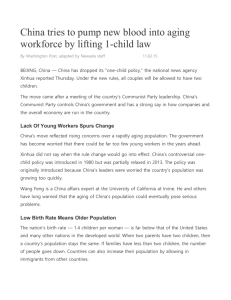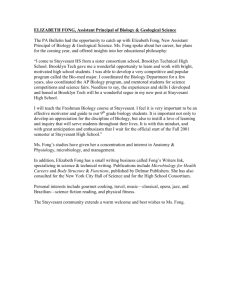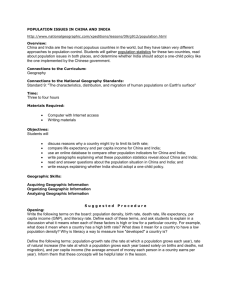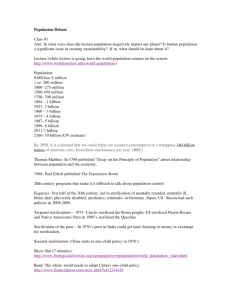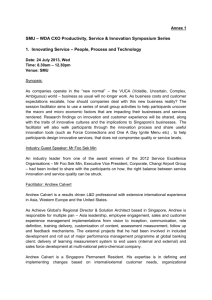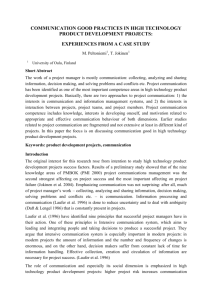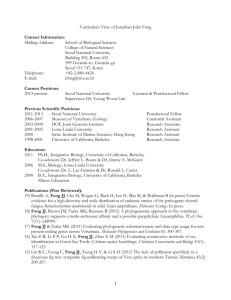Flipping the baby switch
advertisement
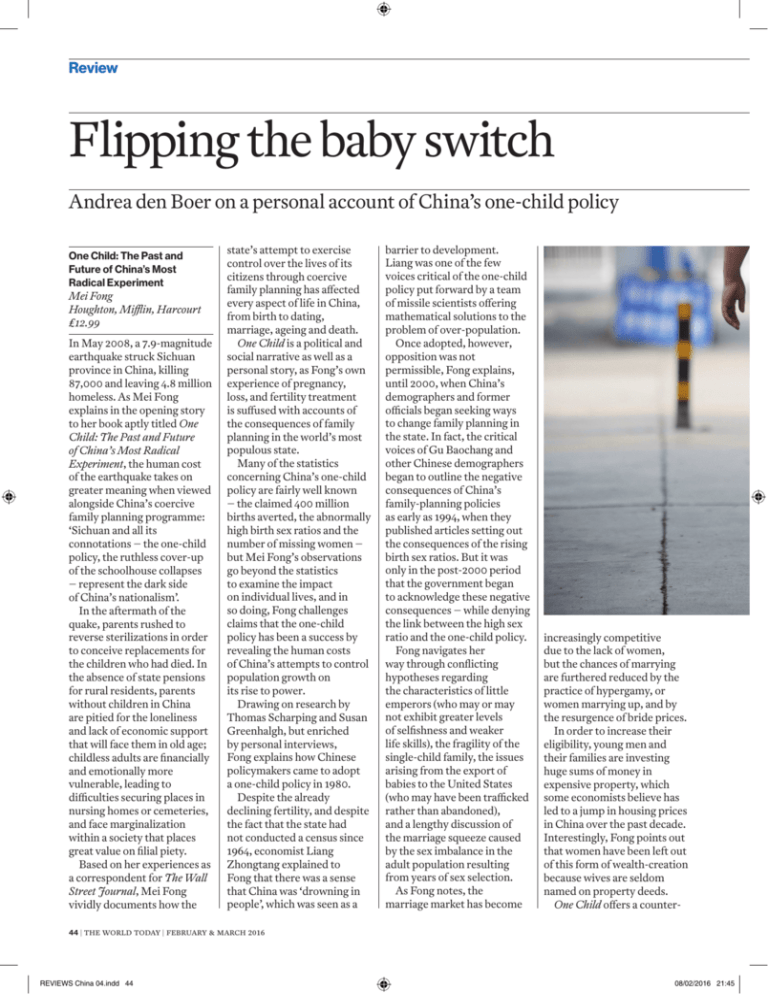
Review Flipping the baby switch Andrea den Boer on a personal account of China’s one-child policy One Child: The Past and Future of China’s Most Radical Experiment Mei Fong Houghton, Mifflin, Harcourt £12.99 In May 2008, a 7.9-magnitude earthquake struck Sichuan province in China, killing 87,000 and leaving 4.8 million homeless. As Mei Fong explains in the opening story to her book aptly titled One Child: The Past and Future of China’s Most Radical Experiment, the human cost of the earthquake takes on greater meaning when viewed alongside China’s coercive family planning programme: ‘Sichuan and all its connotations – the one-child policy, the ruthless cover-up of the schoolhouse collapses – represent the dark side of China’s nationalism’. In the aftermath of the quake, parents rushed to reverse sterilizations in order to conceive replacements for the children who had died. In the absence of state pensions for rural residents, parents without children in China are pitied for the loneliness and lack of economic support that will face them in old age; childless adults are financially and emotionally more vulnerable, leading to difficulties securing places in nursing homes or cemeteries, and face marginalization within a society that places great value on filial piety. Based on her experiences as a correspondent for The Wall Street Journal, Mei Fong vividly documents how the state’s attempt to exercise control over the lives of its citizens through coercive family planning has affected every aspect of life in China, from birth to dating, marriage, ageing and death. One Child is a political and social narrative as well as a personal story, as Fong’s own experience of pregnancy, loss, and fertility treatment is suffused with accounts of the consequences of family planning in the world’s most populous state. Many of the statistics concerning China’s one-child policy are fairly well known – the claimed 400 million births averted, the abnormally high birth sex ratios and the number of missing women – but Mei Fong’s observations go beyond the statistics to examine the impact on individual lives, and in so doing, Fong challenges claims that the one-child policy has been a success by revealing the human costs of China’s attempts to control population growth on its rise to power. Drawing on research by Thomas Scharping and Susan Greenhalgh, but enriched by personal interviews, Fong explains how Chinese policymakers came to adopt a one-child policy in 1980. Despite the already declining fertility, and despite the fact that the state had not conducted a census since 1964, economist Liang Zhongtang explained to Fong that there was a sense that China was ‘drowning in people’, which was seen as a barrier to development. Liang was one of the few voices critical of the one-child policy put forward by a team of missile scientists offering mathematical solutions to the problem of over-population. Once adopted, however, opposition was not permissible, Fong explains, until 2000, when China’s demographers and former officials began seeking ways to change family planning in the state. In fact, the critical voices of Gu Baochang and other Chinese demographers began to outline the negative consequences of China’s family-planning policies as early as 1994, when they published articles setting out the consequences of the rising birth sex ratios. But it was only in the post-2000 period that the government began to acknowledge these negative consequences – while denying the link between the high sex ratio and the one-child policy. Fong navigates her way through conflicting hypotheses regarding the characteristics of little emperors (who may or may not exhibit greater levels of selfishness and weaker life skills), the fragility of the single-child family, the issues arising from the export of babies to the United States (who may have been trafficked rather than abandoned), and a lengthy discussion of the marriage squeeze caused by the sex imbalance in the adult population resulting from years of sex selection. As Fong notes, the marriage market has become increasingly competitive due to the lack of women, but the chances of marrying are furthered reduced by the practice of hypergamy, or women marrying up, and by the resurgence of bride prices. In order to increase their eligibility, young men and their families are investing huge sums of money in expensive property, which some economists believe has led to a jump in housing prices in China over the past decade. Interestingly, Fong points out that women have been left out of this form of wealth-creation because wives are seldom named on property deeds. One Child offers a counter- 44 | the world today | february & march 2016 REVIEWS China 04.indd 44 08/02/2016 21:45 argument to those who believe that the increased demand for women resulting from the sex imbalance will increase the value of women. Although Fong begins by stating that ‘the one group that has substantially benefited from the onechild policy is urban Chinese females’ who, as single children, have had the advantage of being the sole recipient of parental investment in their health and education, she qualifies this statement by later adding that women as a whole are not more valued. As she explains, significant numbers of women have been ‘Liang was one of the few voices critical of the onechild policy put forward by a team of missile scientists’ aborted, abandoned, or killed at birth and ‘the female shortage has resulted in increasing commodification of women’ in the forms of prostitution, sex trafficking, and the kidnapping and sale of women. While urban women mostly comprise the rising numbers of university graduates in China, those who pursue higher levels of education are discovering that too much education hinders their chances of finding marriage partners and they become among the ‘leftover women’ in this hypergamous society. Fong concludes her discussion of the gendered effects of enforced family planning with the reminder that ‘gender discrimination was a poison in China long before the one-child policy’, but unfortunately, her analysis does not extend to a discussion of the roots of son preference. Although Fong interviewed family planning officials about their enforcement of family planning policies – offering some insight into the human face within the massive machinery supporting the state’s policies – individual parents were not questioned regarding the choices they made regarding the sex of their offspring. There is also a tension in her writing between arguing that China’s populace has internalized the one-child norm as ideal, and support family planning (stating that this is ‘easier to understand if you’ve lived there and had to fight for spots everywhere from the crowded subways to elite schools’) and the numerous examples of individuals who hide additional births, undergo IVF to circumvent the one-child rule by giving birth to twins, or those who risk heavy fines to expand their families. To what extent is state control over family planning really accepted within China? Although China has announced shifts in its policy towards a two-child norm, as Fong points out, China will not be able to ‘flip the baby switch on as successfully as it turned it off’. The one-child policy has caused parents to think too rationally about the decision to have a child, Fong argues, and the response of the population to recent changes suggests that she is right. Whether China will gradually increase its fertility rate and reverse current trends in population growth is unclear, however, the problems outlined in One Child – the declining labour force, sex imbalance, and ageing population – will shape China’s future for decades to come. WANG ZHAO/AFP/GETTY China’s one-child policy has caused parents to think too rationally about having a child Andrea den Boer is a Senior Lecturer in the School of Politics and International Relations at the University of Kent and co-author, with Valerie Hudson, of ‘Bare Branches: the Security Implications of Asia’s Surplus Male Population’ the world today | february & march 2016 | 45 REVIEWS China 04.indd 45 08/02/2016 21:45
